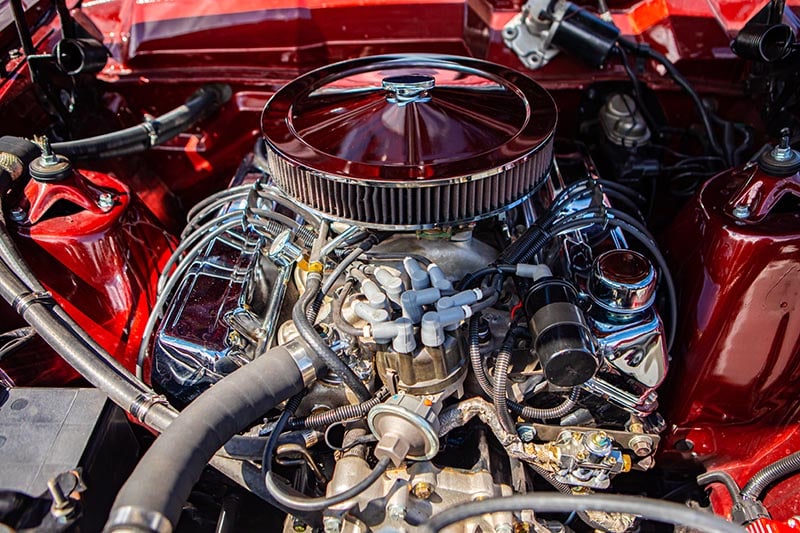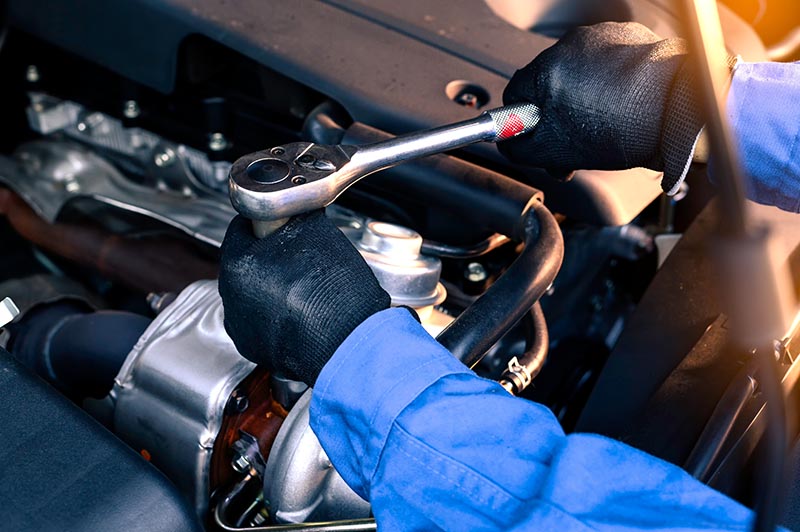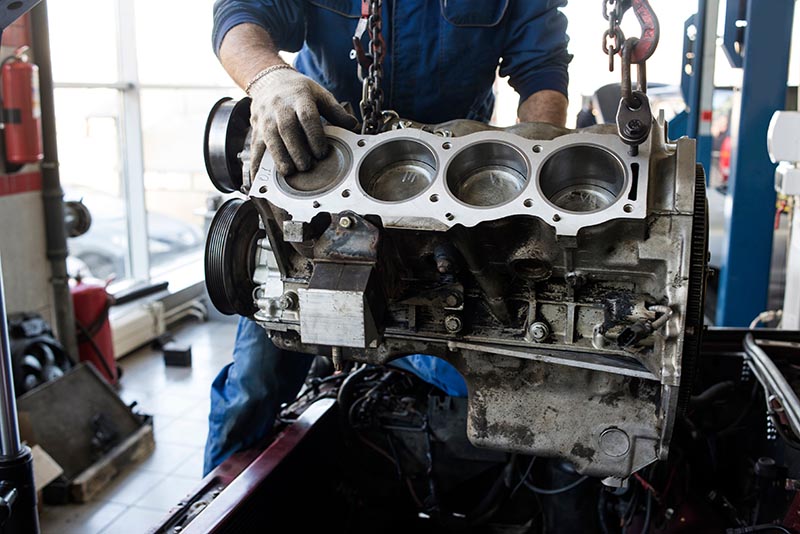What Is a V8 Engine & How Does It Work?
-
Pete Ortiz
- Last updated:

Whenever we think about the engine of a car, we like to think of it as the brain of the operation. Because in essence, that’s what it actually is. Without the engine, the car doesn’t have anything to power it or move it forward. Some people think that it’s the fuel that powers the car not knowing that fuel has to be first converted into an explosion to be effective.
We have several types of engines. You might be working with a Straight engine, Boxer, Wankel, VR & W, an Inline, or our all-time favorite, the V engine. The V engine has its cylinders facing outwards. And depending on the car, the engine might come with four, six, or eight cylinders.
An eight-cylinder engine is commonly referred to as the V8 engine. This type of engine is our subject of discussion today.
How Does the V8 Engine Work?
To understand how the V8 engine works, we have to dissect the parts and study them one by one. We’d like you to think of this engine the same way you would a system. One that can’t function effectively, or even efficiently, in the absence of a vital cog.

Cranks & Crankshaft
Seeing as the V8 engine is a complex concept to some people, we thought it would be wise to explain how it works by starting with the most basic component—the crankshaft. We see it as a basic piece since it’s just a crank strategically placed on a shaft.
But there’s more than one crank in a V8 engine, as you’ll realize that each cylinder needs one. And let nobody try to convince you that the crank found in this system is any different from the conventional one installed in bicycles because they are very similar.
They might not be the same size, but they pretty much do the same job. Also, you’ll only find two cranks in a bicycle, an eight in a V8 engine.
Pistons & Piston Rod
Now that we know what the crankshaft does, let’s move on to the next cog that’s attached to it —the piston. But to understand its prime and only function, we have to first explain what the piston rod is.
If we had to compare the rod to something familiar to most people, we would say it’s more or less like the legs that are pedaling a bicycle. Do you know how you have to push down the bicycle’s pedal to get the cranks moving? That’s what the piston rod does. It pushes the cranks down, inevitably forcing the crankshaft to turn as well.
Sadly though, the rod doesn’t have a mind of its own. To know when to push down the cranks, it relies on the information passed down from other critical cogs in the system. One of those cogs is the piston. This feature has been designed to take the shape of a soup can so that it can fit inside the V8 engine’s cylinder.
However, just because it looks like a soup can doesn’t mean that it’s brittle in nature. It’s a lot thicker and stronger, but roughly the same size as the can.
Combustion Chamber
As you’d expect, the piston gets its information from a different cog. One that is different in the sense that it’s been tasked with sending a force to the piston so that it can keep the crankshaft turning.
The force that we’re referring to usually takes the form of ignition, coupled with a small degree of fuel explosion in the presence of air. This crazy reaction often takes place in a chamber, commonly referred to as the combustion chamber. It’s in this chamber that you’ll find the vehicle’s spark plug together with the valves.
The work of the spark plug is to provide the spark needed to ignite the reaction and ultimately cause an explosion.

Cylinders & Cylinder Block
Before we talk about the cylinders, we have to say something about the engine block. This part of the V8 engine is popularly known as the cylinder block, and it’s like the motherboard of a computer system. Being the chief structure you’ll find that all the other components of the engine are either built around it or into it.
One of those components is the engine cylinder. This feature is always hollow and often takes on a cylindrical shape so as to fit inside the engine block.
In the block, we have a total of eight cylinders. But you’ll find them arranged in two sets of four, forming a shape that resembles a V. Their main task is to hold the piston while providing them with a little bit of space to move up and down. That space is so tight-fitting that nothing can get in or out. If you’ve ever heard a mechanic talk about “the seal,” now you know what that is.
The seal is absolutely necessary for this whole process because it makes sure that the explosion remains confined within the cylinder, but above the piston. It has to be above the piston, seeing as it’s the force that pushes it down, ultimately turning the crankshaft.
Valves
While the engine’s running, other things will be going on in the background. For example, we have the opening and closing sessions of the valves. All the vehicles that come with the V8 engine have two types of valves: intake and exhaust valves.
The function of the intake valve is to give two things access to the combustion chamber—air and fuel. Once those two elements have been ignited, the burnt exhaust will be released through the exhaust valve. So, as you can see, several components of the engine will be working simultaneously to ensure the vehicle gets a steady supply of power.

Where Is the V8 Engine Applicable?
It’s important to know which type of engine best caters to your needs before purchasing a car. For example, if you’re going to need a vehicle that can handle rugged terrains, the engine has to be a powerful one. Let’s assume you’ve been given the option of choosing between a V6 and a V8 engine. What are some of the things that you’d take into consideration?
For starters, both of those engines have the same cylindrical formation—the V shape. But the V6 has six cylinders while the V8 comes with eight. The latter is an upgrade because it’s been designed to generate more power, hence making the car move relatively faster. The power delivery is also efficient because the cylinder banks have been installed at a perpendicular angle.
From a fuel economy perspective, we wouldn’t encourage you or anyone else to go with the V8 engine. Unfortunately, being able to generate more power means consuming a lot more fuel than its predecessors. Therefore, if you’re looking for a car that you can use to drive around the city, this is not the engine for you. The overall expenditures are high, including the maintenance costs.
The friction generated by this engine is yet another problem to think about. It’s higher than the V6 or V4, meaning the components wear out faster. Also, a significant percentage of the energy produced goes into making sure those parts keep moving.
- Has a compact design
- Generates more power
- Ideal for rough terrains
- Delivers more speed and acceleration
- Can transport more stuff
- Efficient power delivery
- Sounds better at high acceleration
- High maintenance
- Generates high engine friction
- Poor gas mileage
- Will drain your bank account

 Frequently Asked Questions (FAQs)
Frequently Asked Questions (FAQs)
What’s The V8 Engine Good For?
The V8 engine is mostly found in sportscars, SUVs, and pickup trucks because it’s been designed to produce a lot of horsepower and torque. It also has what we call a higher engine displacement. If your car has a high engine displacement, what that basically means is, that it’s been designed to move more air and fuel, thus giving it the ability to generate more power.
Is The V6 Turbo Comparable to The V8 Engine?
From what we’ve experienced, we feel like the turbocharged V6 is a way better option if you compare the two. First off, they are so reliable and have the potential to generate more horsepower in comparison to the V8. Secondly, their fuel economy is nothing like what we’ve seen in the V8, hence making it possible for us to save more.
Why Are V8 Engines Popular?
It’s natural for people to always want to go for the things that are most talked about. And this is what we’re seeing in the car culture. Everyone wants to own an SUV with a V8 engine because the market can’t stop talking about the power it delivers.
Cars made with this engine are also expensive, thus making them less affordable in low-income households. Owning such a car will make other people think you belong in the high echelons of society, and that’s a psychological need that we often strive to achieve.
Conclusion
Just to recap what we’ve talked about, the V8 engine is called “V8” because it has eight cylinders (in two sets of four) that create a V shape. Compared to the V4 and V6, it generates more horsepower and torque. Is its fuel economy desirable? No. And it’s one of the prime reasons why most potential car buyers try to steer clear of it.
Featured Image Credit: Ansis Klucis, Shutterstock
Contents


